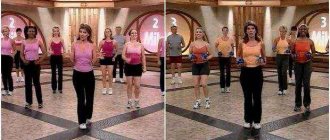What is health running
There is walking and there is running, and these are perhaps the two most natural exercises for a person. However, running itself can be very different, and it cannot be said that Olympic champions and other elite athletes are the healthiest people on the planet, despite the enormous benefits of running for the human body. Believe me, running for the purpose of results is far from healthy.
Health running, in turn, is an easy run, where speed is not an end in itself. In other words, such running acts as a therapeutic and preventive procedure, and not as a sports exercise. Another three-time Olympic champion Tatyana Kazankina said: “Running is knocking out psychological stress with physical stress.” Therefore, the main goal of recreational running is to relieve nervous tension, which in advanced cases has a serious impact on health.
What is the best way to help you lose weight?
Both running and walking are physical activities of different intensity that require energy expenditure. Deep ventilation of the lungs and activation of oxidative processes allow you to speed up metabolism and reduce the deposits of fatty tissue in problem areas.
If you compare running and walking and talk about which is better for losing weight, the choice is definitely in favor of running
It is not advisable to choose a suitable method on your own; it is better to contact fitness specialists, they will help you weigh the pros and cons in order to make a choice in favor of running or walking for weight loss. In general, it is necessary to take into account the age, physical condition of the person, the presence of concomitant diseases of the cardiovascular or musculoskeletal system, in order to avoid unwanted complications.
The benefits of healthy running and its effect on the body
Health running, as its name suggests, will not harm the practitioner. Among other things, running for health also helps you lose weight. But remember an important rule: you can only lose weight if you do not compensate for the loss of energy as a result of running by increasing calories. The body switches to its own fat reserves only when there is a calorie deficit.
Running increases the body's reserve capabilities: there is an increase in the supply of nutrients in the cells, an increase in the mass of the heart muscle, and massage of the internal organs with the diaphragm during deep breathing. Let's consider this issue in more detail.
Subscribe to “Marathon Man” on Telegram. Announcements of articles and useful selections every week.
The effect of running on the body is colossal: this exercise affects not only the heart, but also digestion and the psychological state.
- The cardiovascular system
With an increase in heart rate, your blood is more actively distributed throughout the body, as a result of which metabolic processes are accelerated, organs are saturated with blood and oxygen, and toxins are removed from the body faster. The heart becomes stronger and stronger: regular health running helps strengthen the walls of the heart and increase its systolic volume. All this reduces the risk of heart disease, in particular heart attack.
- Respiratory system
During even a slow run, a person breathes more actively, and, therefore, the lungs are ventilated more intensively. This strengthens them, so catching a cold will no longer be so easy. Doctors say that running helps restore lungs after quitting the bad habit of smoking.
- Muscles and joints
Healthy running uses a large number of muscles, making them stronger and more resilient. While running, a special load is placed on the muscles of the legs, back, and abs.
- Musculoskeletal system
If you lead a sedentary lifestyle, be sure that your joints and bones will become increasingly susceptible to musculoskeletal diseases over time. Running will come to the rescue, which will save you from bone tissue atrophy.
- Digestion
It would seem that running can only have a beneficial effect on the muscles and musculoskeletal system, but its positive effect also extends to human digestion. When running, the likelihood of stones appearing in the gall bladder decreases, and stagnation does not form in it. The liver of a person involved in recreational jogging is also, of course, less susceptible to various diseases.
- Psychological condition
Have you felt the runner's euphoria? Any activity, and running in particular, protects a person from nervous tension due to the production of the hormone of happiness - endorphin.
Healthy running can be recommended to combat neurasthenia and insomnia, which arise from nervous overstrain. When a person moves, his sleep improves, which is followed by an improvement in overall well-being and increased mental performance.
Special medical literature states that evening running is especially useful for relieving negative emotions. Have you ever noticed how calm and joyful you feel after running? So, in psychiatry, patients are recommended to perform cyclic exercises to treat depression.
Interestingly, a change in the personality type of a person who has been jogging regularly for many years has also been noticed: running helps to become more sociable and confident in one’s abilities.
Running or Walking: Key Differences
- If your goal is to lose weight in a short time, then choose running.
- Scientists have found that after jogging, a person’s level of a hormone that reduces hunger increases. Therefore, those who run eat less than race walkers.
- There is a higher risk of injury while running. And for some people, this becomes a decisive factor when choosing the type of cardio exercise.
- Californian scientists have found that walking at a fast pace is better for the heart than even light jogging.
- Comparing regular running, sports and Nordic walking, which is popular today, it is worth noting that the latter is safer and healthier. Nordic walking is different in that the athlete leans on poles, unloading the spine and insuring himself from falling. Additionally, the athlete works to improve coordination. During training with poles, more calories are burned (about 50%) than during normal walking, because different muscle groups are stressed.
- When a person walks, most of the load falls on the legs, or more precisely on the calf muscles. The upper body is practically not involved. While running develops the muscles of the back, shoulder girdle, abdomen, hips and buttocks.
How to decide which is better?
How do you know which is better for you: running or walking? Which sport should you choose to get your body in shape without harming yourself?
The choice of type and intensity of exercise depends on the goal, physical condition, existing chronic diseases, age and training of the person. It is quite difficult for someone who has never been involved in sports to run several kilometers without preparation. And this will be a huge stress for the body. Therefore, if you decide to lose weight through cardio or take your health seriously, start with brisk walking. When it becomes easy, start running.
Older people need to be very careful. Of course, there are examples of older people participating in marathons and even winning. But this is probably preceded by serious preparation and mandatory observation by doctors. After all, the state of the cardiovascular system of an elderly person who has been involved in sports all his life and his peer who is not accustomed to physical activity is very different. Therefore, Nordic walking is considered the optimal cardio workout for older people.
And the last thing you should pay attention to when choosing the type of load is pleasure. Activities that bring joy and charge you with positive emotions are in any case better than boring and hateful, but useful workouts.
Karina Grishanova | 06/23/2015 | 1220
Karina Grishanova 06/23/2015 1220
Both running and walking have their advantages and disadvantages. During running, the body experiences higher stress, so it is more suitable for people with a good level of physical fitness. At the same time, running is one of the most effective types of cardio training.
Walking, on the other hand, is best for beginners. It increases muscle performance and endurance, but does not lead to overwork.
Let's figure out which sport is right for you.
What are the benefits of running?
While running, almost all muscle groups work, but the amount of load on them varies. The muscles of the arms are the least involved, but if you wish, you can load them too by taking small dumbbells with you for a run.
Of course, if you set out to build muscle mass, then you should do strength training, not running. Running training is aimed primarily at developing endurance.
With regular health running, the following changes occur in the body:
- the cardiovascular system is trained;
- pulmonary ventilation improves;
- body tissues are saturated with oxygen;
- the muscle frame is strengthened;
- body weight is normalized.
Running for weight loss is recommended for people whose body weight exceeds the norm by no more than 10 kg. It is recommended to run for at least 30 minutes at least five times a week. With this training regimen, excess calories are burned most effectively.
Jogging at a speed of 9-10 km/h is optimal in terms of energy consumption. In this case, predominantly aerobic oxidation occurs, which allows the energy of fat breakdown to be used. The heart rate increases approximately 1.5-1.7 times compared to the resting heart rate, which trains the cardiovascular system without overload.
What are the benefits of walking?
Despite the undeniable benefits of running, many training programs are focused not on it, but on race walking. Let's figure out why this happens.
Firstly, walking is accessible to everyone. Only people with a sufficient level of physical fitness can run 5-6 km a day. Any person can walk the same distance, even with any diseases.
Secondly, while walking, the spine and leg joints do not experience the same load as when running. When, during running, the body first comes off the ground and then comes into contact with its surface, there is a fairly noticeable impact on the joints and ligaments. If you are overweight, this can become a serious problem.
During intense walking, the heart rate increases by 50-70% of resting values, which is a sufficient stimulus for training the heart and blood vessels. Walking is more effective for losing weight, since with such a load fat is burned, while during running, mainly carbohydrates are consumed. At the same time, energy consumption per 1 km of distance traveled when walking is slightly greater than when running.
Another advantage of walking is that you can do it in between, incorporating walking into your daily routine.
As for the technique of performing movements, you can use elements of race walking. Swedish walking with poles gives a good load on the upper body. The speed should be quite high - approximately 6-7 km/h.
At this pace, 1 km is covered in 10-12 minutes. It is also useful to alternate the pace: 2-3 minutes at the fastest pace, 2-3 minutes at a comfortable speed. From time to time you can practice walking up stairs or on difficult surfaces (rough terrain, sand, pebbles).
Who is walking and who is running?
There is no clear answer to the question of which is better - running or walking. Experts agree that the type of physical activity that brings you pleasure is most effective.
Still, you should give preference to walking in the following cases:
- body weight is 5-10 kg above normal;
- spinal and knee injuries;
- inability to jog at least 5 times a week;
- the presence of diseases of the cardiovascular system or asthma with frequent attacks.
Running helps relieve stress, obsessive thoughts, bad mood and depression. Walking promotes leisurely reflection and meditation.
If you still haven’t decided for yourself which is better – running or walking, don’t worry. Physical fitness instructors find combining the two to be very beneficial. In this case, you need to alternate between fast walking and jogging in one workout, allotting 5-10 minutes for each type.
Today we will look at the positive and negative effects of running and walking on the body and compare them.
Where is it better to run?
The best place to go for a healthy run is in nature. Running along a busy highway means inhaling exhaust fumes. Additionally, asphalt, concrete, and paving slabs are hard on your feet, which can lead to injury.
In urban conditions, the solution for recreational running is a rubber-covered stadium. But it’s still much more pleasant to run in the forest, inhale the aroma of pine needles or herbs, listen to birds singing, giving your eyes and head a break from the monotony.
Those who are just starting to run should not strive for very rough terrain. To begin with, a flat track with natural surface will do. As you gain experience, feel free to include gentle climbs in your routes, but it is best to go down hills on foot, so as not to strain your joints.
Read on the topic: Where to run in Russian cities
Can you hurt yourself while running?
The answer may be surprising after all the benefits given, but in some cases running can be really dangerous. To run without worry, before your first run, visit your doctor and get the necessary tests. Diseases of the spine, ligaments and joints of the legs are not something that will benefit you from running.
- Be regular and systematic in your studies. At first, the euphoria may make you want to run every day, but this is not recommended. Don't overload your body, let it adapt. The recommended figure for increasing the volume of runs is 10% per week.
- Your health running is not a sports run. You don't have to look for your maximum. Run for fun, but remember that your body will not like it if you train occasionally. If possible, do not miss scheduled classes.
- Don't run at night. At night you should sleep and recover. It’s still better to skip a run if you leave late that day, but running for the sake of running is far from the best solution. You should also skip training when you are ill - there is no need to put extra stress on a weakened body.
Some people should run, some people should walk
If you are still faced with the question of whether to choose walking or running, then first of all you should pay attention to your level of physical fitness. After all, it plays a decisive role in choosing the type of preferred physical activity.
If you have chronic or acute diseases, it is advisable to start with regular walks in the fresh air, gradually adding elements of race walking. After a month or two, when your endurance has increased, you can move on to jogging, and eventually to long runs.
The complete absence of pathologies, young age and a large amount of energy allows you to immediately switch to running without developing undesirable consequences for the human body.
Contraindications for jogging
Just as you should consult a doctor when taking medications, it is also important to visit a doctor when starting to run. Running is useful, but only if you have no personal contraindications. Do not ignore this recommendation, because if you are prohibited from running, it can become a real enemy to your health. Go to your GP, get a referral to a cardiologist and surgeon, and then consult with a sports doctor.
Doctors do not recommend running if you have:
- chronic joint pain;
- diseases of the central nervous system, such as epilepsy;
- diseases of the cardiovascular system, for example, heart rhythm disturbances or a recent heart attack;
- respiratory diseases (asthma with frequent attacks);
- severe mental illness;
- liver diseases, if they are accompanied by frequent painful attacks;
- exacerbation of diseases of the digestive system;
- osteocondritis of the spine;
- all diseases with incomplete cure or in the acute stage.
Pregnant women are better off walking instead of running. The same applies to overweight people. Running in this case will have a negative impact on the musculoskeletal system.
Walking for health
Regular walking exercises have a positive effect on the condition of all systems and organs of the body. During a walk, the respiratory system is actively working, harmful substances are eliminated, including harmful chemical compounds.
In order to determine what exactly is less traumatic and more beneficial for the health of a particular person, it is necessary to take into account the following parameters:
- age;
- the presence of concomitant pathologies of the cardiovascular, endocrine and musculoskeletal systems;
- history of surgical interventions.
In addition to the positive effect on physical health, playing sports has a beneficial effect on the human psyche. The acute or chronic effects of stress are leveled. This is due to the lack of time for sad thoughts and tormenting oneself about various situations.
Where to start with recreational running
All the benefits can come to naught if your running technique is far from correct. In this case, the knees, lower back and ligaments are put under attack. Pay attention to the soft positioning of your feet without “sticking”, try to run on a full foot. The main thing for you is uniform loading of the foot.
Stride length is another technical point worth mentioning. A step that is too long will require more effort and will increase the load on the spine, and running mincingly will not provide the proper healing effect for the body. In the latter case, the muscles will contract very slightly, while the joints, on the contrary, will be subject to frequent pushing forces.
While running, do not slouch, avoid swaying, keep your posture upright.
You've already realized that after visiting your doctor, it would be wise to read and watch videos about proper running technique. Study the issue, because in the future this will help you avoid overloading the spine and joints. What's the point of running if after a few sessions you can't straighten your back?
Running technique
The benefits of running directly depend on the correct technique. According to the laws of biomechanics, running technique must comply with the following rules:
- load regulation - you need to run easily and naturally, you should not overload the body with excessive speed or duration of the run;
- correct placement of the foot - during running, the heel should first touch the base, and then gently move to the toe;
- step length – when running, you must adhere to the natural step length; it should not be lengthened or shortened so as not to bump into your forward leg;
- posture - the torso should be positioned vertically without bending forward or leaning back, otherwise the benefit from the exercises will be minimal.
Maintaining the correct running technique will ensure an even load on the joints and increase the effectiveness of your workouts.
Health running. Let's start training
Let's move on to training. As soon as you've eaten, don't immediately go for a run. The minimum break time between running and eating is 30 minutes. Training should always include warming up the muscles. The scheme is something like this:
- Warm-up: circular movements of the arms, torso, pelvis, bending forward and to the sides, swinging legs, squats, raising toes.
- Gymnastics with working out the main joints for running.
- 2-3 minutes of brisk walking.
- Even running.
- Cool down (very slow running) followed by walking for 2-3 minutes.
- Exercises to stretch and relax muscles.
How often should you run?
Professional runners often train every day and do heavy running work. But for running for the purpose of health improvement, this is not at all necessary and is even rather harmful, especially for beginners.
At first, run three times a week for at least 20 minutes (completely beginners alternate running and walking). Do not rush to increase the volume of training, increase the load gradually. When you cross the threshold of 10 minutes of continuous running, add 1-3 minutes to it.
It is also important to mention running speed. Since the main goal of recreational running is to increase the adaptive capabilities of the cardiorespiratory system, you should not chase someone who runs faster than you if you feel that it is too difficult. Some achieve the main goal of therapeutic running at a speed of 10-12 km/h or faster, while others achieve it at 7 km/h or slower.
It’s easy to understand what your pace is: if you can maintain a conversation, you have enough strength to make coherent sentences, you have chosen the optimal pace for yourself. Many people give up on their activities because they are simply overworked on them, and running begins to be associated with pain and discomfort.
Differences between running and walking
In order to understand which exercise is more effective in a particular case, you need to know the differences.
In order to better strengthen muscles, running is, of course, preferable
The main points that make up the fundamental difference between running and walking include the following:
- walking involves the muscle group of the lower leg, while running involves the bundles of the shoulders, chest, thigh muscles, as well as the gluteus maximus, medius and minimus muscles;
- while running, for a split second a person is in a state of flight; this phase is completely absent when walking. Constant jumping leads to severe stress on the cartilage tissue underlying the intervertebral discs and joints;
- the heart rate while walking is much lower, due to which there is rarely a feeling of coldness behind the sternum, and a person can exercise longer;
- running for more than fifteen minutes uses all the sugar freely circulating in the bloodstream, active fat burning processes are launched;
- walking has less impact on chronic stress, since only while running, due to the high load, a person is distracted from his thoughts and can relax mentally;
- when choosing running, you need to monitor your own heart rate so that it does not exceed one hundred and forty beats per minute, since it is the range from 120 to 140 beats that allows you to burn fat tissue as efficiently and quickly as possible.











